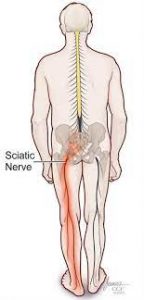Table of Contents
What is sciatica?

Sciatica is a kind of pain that begins along the path of the sciatic nerve. It branches from the lower back through the hips, buttocks and down the leg. Typically, sciatica affects only one side of the body.
Sciatica most commonly occurs when there is a compression on the part of the nerve. It causes inflammation, pain, and numbness in the affected leg.
How bad is my sciatica?
Mild: You may have occasional back pain, tingling, occasional numbness, and weakness in the leg. Most of the time, it can be safely managed at home by following the tips in the mild sciatica section below.
Moderate: You may have frequent back pain, tingling, shooting pain, and numbness in the leg. Moderate sciatica can be safely managed at home but sometimes it may require the medical assistance.
Severe: Unbearable back pain, numbness, tingling, and weakness in the lower back or leg. Severe sciatica may be an emergency if it is stopping you doing your self-care activities (eating, dressing, getting into or out of a bed or chair, taking a bath or shower, and using the toilet). It requires additional medical treatments including physiotherapy.
How to manage mild sciatica?
Keep track of your symptoms using Ankr (myAnkr web portal or the Ankr app). It will help you describe the discomfort to your doctor or nurse.
It’s not always possible to prevent sciatica, and the condition may recur. The following can play a key role in protecting your back:
- Exercise regularly. To keep your back strong, pay special attention to your core muscles — the muscles in your abdomen and lower back that are essential for proper posture and alignment. Ask your doctor to recommend specific activities.
- Maintain proper posture when you sit. Choose a seat with good lower back support, armrests and a swivel base. Consider placing a pillow or rolled towel in the small of your back to maintain its normal curve. Keep your knees and hips level.
- Use good body mechanics. If you stand for long periods, rest one foot on a stool or small box from time to time. When you lift something heavy, let your lower extremities do the work. Keep your back straight and bend only at the knees. Avoid lifting and twisting simultaneously.
- Over-the-counter painkillers
- Physical therapy
- Cognitive behavioral therapy (CBT) helps manage chronic pain by training people to react differently to their pain
Surgery may be an option if symptoms have not responded to other treatments and continue to intensify. Surgical options include:
- Lumbar laminectomy – widening of the spinal cord in the lower back to reduce pressure on the nerves.
- Discectomy – partial or entire removal of a herniated disk.
How to manage moderate and severe sciatica?
Mild sciatica usually goes away over time. Call your doctor if self-care measures fail to ease your symptoms or if your pain lasts longer than a week, is severe, or becomes progressively worse. Get immediate medical care if:
- You have sudden, severe pain in your low back or leg and numbness or muscle weakness in your leg
- The pain follows a violent injury, such as a traffic accident
- You have trouble controlling your bowels or bladder
What causes sciatica?
- A ruptured intervertebral disk
- Narrowing of the spinal canal that puts pressure on the nerve, called spinal stenosis
- An injury such as a pelvic fracture.
- Spondylolisthesis
- Osteoarthritis
- Trauma
